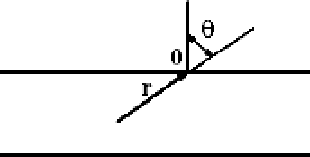Environmental Engineering Reference
In-Depth Information
3.3.4
Emission from a Flat Plasma Layer
Excited atoms can emit photons, and these photons can be absorbed by atoms in
lower states of the radiative transitions, so the processes of radiation of excited
atoms and absorption of atoms in lower states are determined by the character of
plasma emission and propagation of these photons through a plasma. We study
below the characteristics of interaction of resonant photons with a plasma, where
resonant photons result from radiative transitions in atoms and their absorption
by atoms causes an inverse transition between atom states. We consider firstly
emission from a flat layer of a uniform plasma. For definiteness, we assume that
the photons result from radiative transitions between the resonantly excited and
ground states of atoms and take the statistical character of the elementary emis-
sion act, that is, the frequency distribution of photons is described by the photon
distribution function
a
ω
, which is normalized according to (2.134) as
R
a
ω
d
1.
Absorption of photons of this frequency by plasma atoms is characterized by the
plasma absorption coefficient
k
ω
,so1/
k
ω
is the mean free path for this photon in
a plasma. One can introduce also the optical thickness of this plasma:
ω
D
Z
k
ω
dz
,
u
ω
D
(3.73)
where the photon propagates in the
z
direction.
Let us evaluate the photon flux from a plane plasma layer of thickness
L
for the
geometry given in Figure 3.11. Here
x
is a direction perpendicular to the plasma
surface, and
is the angle between this direction and the direction of movement
of a test photon. In the case of an optically thick plasma,
u
ω
D
θ
k
ω
L
1, all the
photons reach the plasma surface, and the flux of photons
j
ω
from the plasma
surface is given by
Z
N
(
r
)
d
r
τ
cos
θ
j
ω
d
ω
D
r
a
ω
d
ω
.
4
π
r
2
We use here the layer uniformity along the plane direction, and therefore the pho-
ton flux is directed perpendicular to the plasma boundary, and
r
is a radiation point
in the frame of reference where the origin lies on the plasma boundary. Next,
N
(
r
)
is the number density of radiating atoms at a given point,
τ
r
is the radiative lifetime
Figure 3.11
The geometry of photon emission.
is the distance that is traveled by the photon
in a plasma,
θ
is the angle between the photon direction and the direction perpendicular to the
plasma surface.
r

